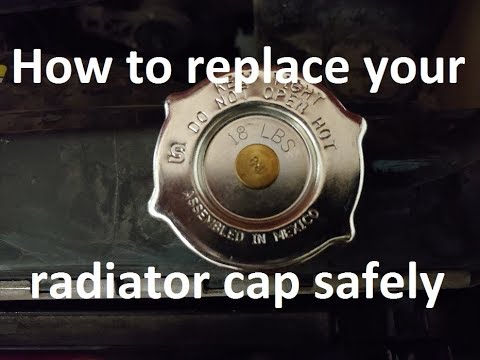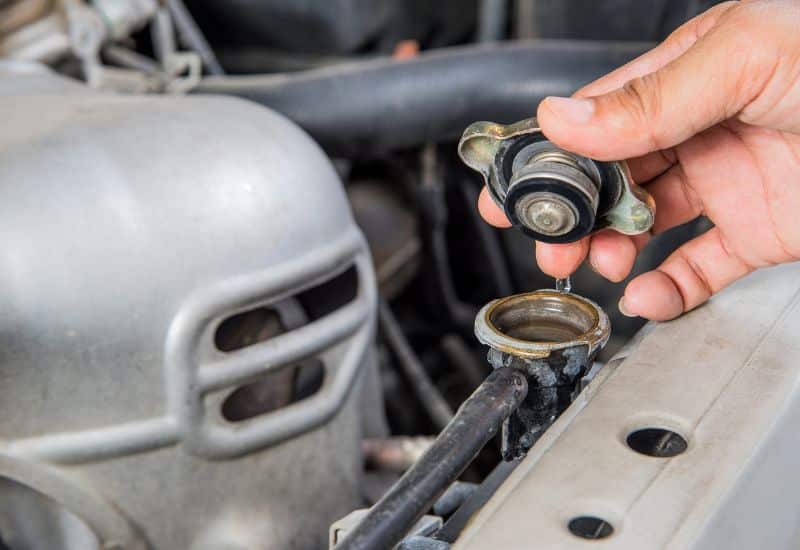
Your car’s radiator cap is one of those things that’s very easy to ignore right up until it has a problem. The radiator cap is engineered to regulate the pressure inside your car’s coolant system. It prevents pressure-related damage from affecting the various hoses, radiators, and other critical components as the system heats and cools.
A bad radiator cap that fails to manage the pressure changes of a normal engine operating properly can lead to issues like coolant lakes, overheating problems, and various other mechanical failures.
If you’ve noticed your car runs hotter than usual, coolant drips in the engine bay or beneath your vehicle, or some of your hoses look strange, you may have a faulty radiator cap that requires replacement.
Knowing how to diagnose the bad radiator cap problem, eliminate other potential causes, and how to replace it properly the first time will go a long way toward preventing more severe damage to your engine.
What Does A Radiator Cap Do?
A radiator cap has a built-in return valve that allows air from the surrounding environment and coolant from an expansion tank. This allows the volume within the coolant system to change as the car’s engine heats and cools.
Once you turn the engine off, the volume of fluid contracts significantly, and the radiator cap allows air to be drawn in to balance out the pressure. All without bringing in airborne debris, which could foul the system.
When you start the car again, and the engine starts to produce heat, the coolant fluid expands, and the air is pushed out. This allows the coolant to flow through the engine, the heater core, and other components to help keep the engine within its normal safe operating temperature.
5 Tell-Tale Signs of a Bad Radiator Cap
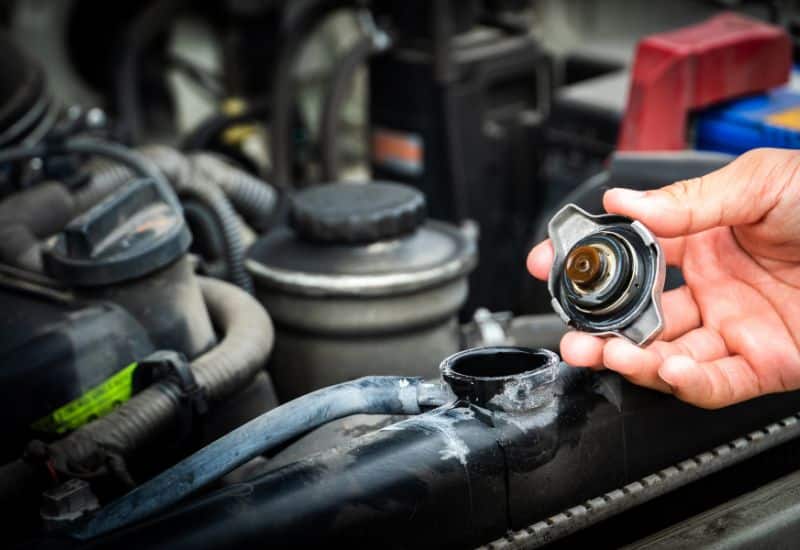
A bad radiator cap may display noticeable signs, such as visible cracks, a worn rubber seal, corrosion on metallic components, or a weak or broken spring. If a radiator cap is faulty and cannot manage pressure fluctuations in a well-functioning engine, it could lead to problems such as coolant leaks, engine overheating, and additional mechanical failures.
Signs of a bad radiator cap can often start out subtle but increase quickly as the coolant level in the system starts to change.
Watch out for the following signs that may suggest a malfunctioning radiator cap:
1. Leaking Coolant & Low Coolant Levels
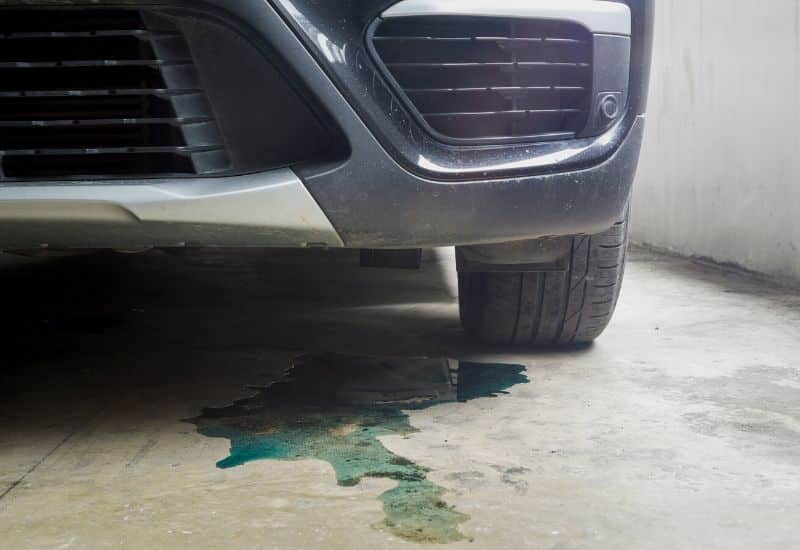
A bad radiator cap will often start to show a problem with seemingly minor coolant leaks and gradually decreasing coolant levels.
Coolant leaks caused by a bad radiator cap can sometimes be hard to spot at first, as the level often changes with the engine temperature. So, you must check the coolant level for reference only once the engine has completely cooled down.
The radiator cap ensures that the coolant stays where it belongs inside the engine and the cooling system. If the valve in the radiator cap is faulty or malfunctions, it can cause pressure to build up within the radiator when the engine is hot. This can lead to various problems, including leaks, overheating, and damage to the engine.
As it superheats, the coolant starts to push its way through the areas around the radiator cap or anywhere else that it can find a way for the pressure to escape, such as gaskets and hoses. Once it finds a weak point or two, the hot coolant starts to seep out. You’ll then notice drops of coolant left behind when you park your hot car.
2. A Bad Radiator Cap Can Cause The Engine To Overheat
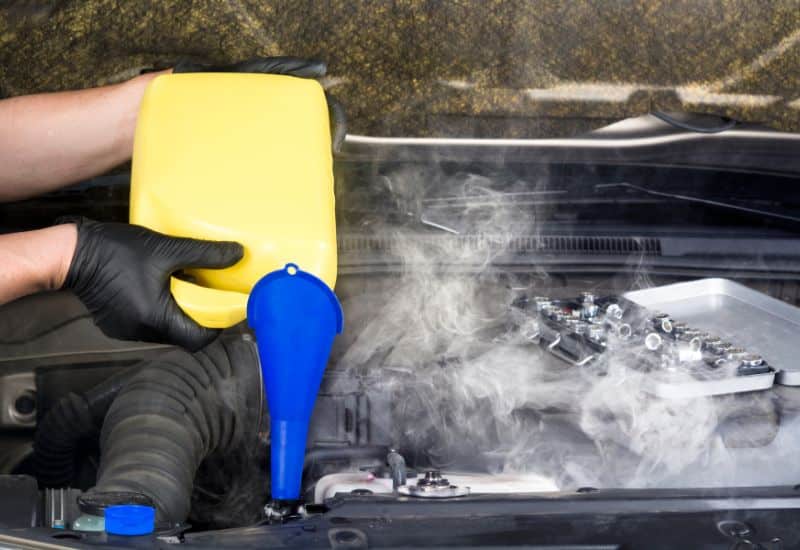
As more and more coolant leaks from the system due to a bad radiator cap, the engine will have an increasingly harder time staying within the safe operating temperature. This will lead to the engine running hotter and hotter to the point of overheating.
The longer your engine is allowed to run hot or at risk of overheating, the more likely you will suffer problems with spark plugs and head gaskets and the very real risk of cracking the cylinder head.
Sometimes this can mean something as simple as the radiator cap not having a good seal, which allows air to make its way into the system, creating small pockets that prevent the proper circulation of coolant, which can lead to engine overheating.
In a scenario like this, the engine might not be running hot, and suddenly the heat starts to spark. It’s most likely to happen during summer stop-and-go traffic or when you’re driving on the highway with a tailwind.
3. Radiator Hoses Appear Collapsed
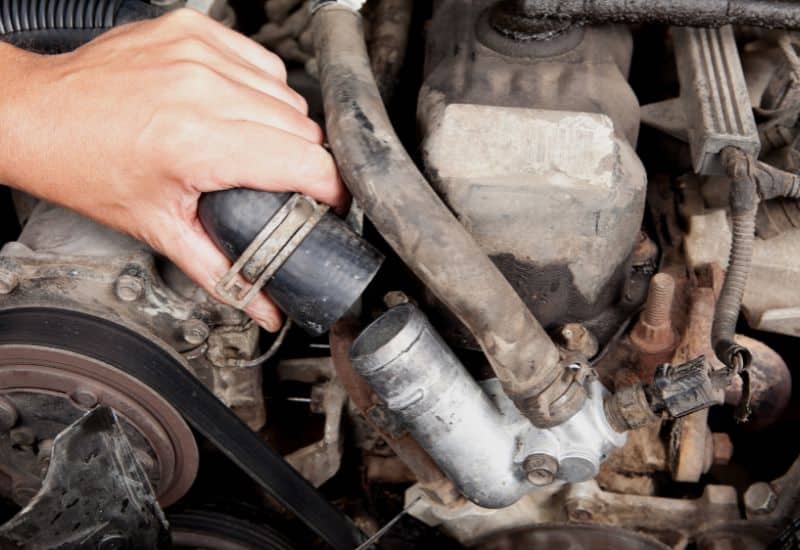
A collapsed radiator hose is a conspicuous indication of a malfunctioning radiator cap. Radiator hoses operate under a vacuum as they help push the coolant through the system. However, when a defective radiator cap cannot can’t regulate the pressure caused by the temperature changes during the engine’s normal cooling process, the hoses can collapse due to excessive internal suction.
You’re most likely to find collapsed radiator hose connected to the expansion tank. If the hose collapses severely, it can sometimes affect the seal, causing it to pull loose.
A modest amount of fluid spills out, and the collapsed hose expands back into shape. This can trick you into thinking that the hose or the hose clam failed when it’s actually a bad radiator cap that caused the problem in the first place.
4. Radiator Hose Bulges or Ruptures
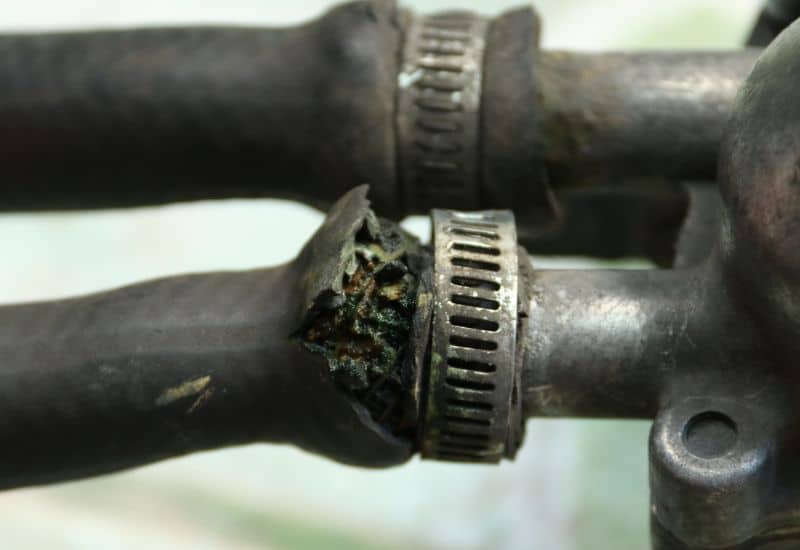
On the opposite end of the spectrum, from a hose collapse, problem with the radiator cap can cause a radiator hose to bulge or rupture. This results from high pressure when the coolant fluid is very hot.
If the hose clamp manages to hold, the hose itself will bulge and might stay partially deformed even after the system cools.
If the structural integrity of the hose can’t handle the high pressure and heat, the hose itself can rupture, and/or the hose clamp can come loose.
This is most likely to happen when you are driving on the highway or in stop-and-go traffic. You often get an alarming blech of steam as the coolant sprays into the hot engine bay, followed by the temperature gauge on the dash rising rapidly.
5. Coolant Comes Out Of Radiator Cap Or Overflow Tank Reservoir
Sometimes a faulty radiator cap can cause the pressure to release too quickly, causing an overflow at the reservoir tank.
Though this could also be due to a stuck thermostat, an undiagnosed water pump problem, or some other type of radiator malfunction. So, don’t instantly conclude that it’s the radiator cap without eliminating those other possible sources.
Step-By-Step Guide: How To Pressure Test Your Radiator Cap To Check For Leaks
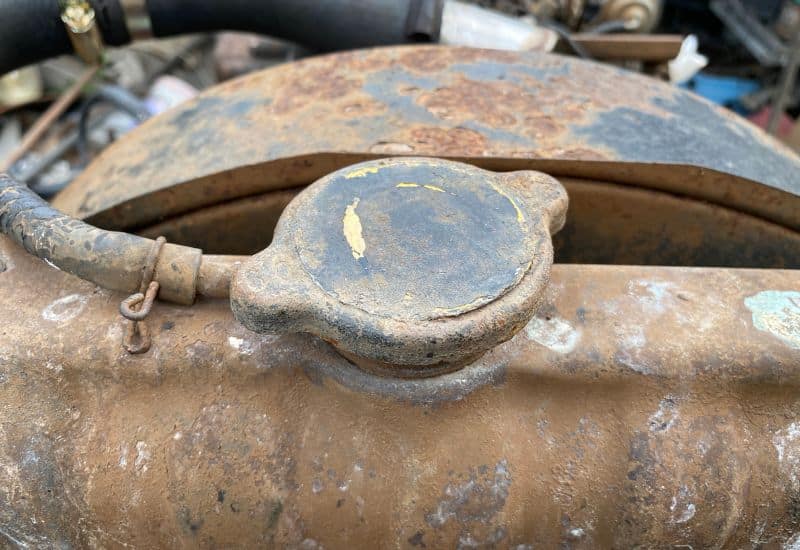
You’ll need a pressure tester to test for a bad radiator cap or eliminate it in search of another fault in the engine cooling system. There are several radiator cap pressure testers you can buy online or at an auto parts store, and the best one for you will depend on your specific needs and preferences. Here are a couple of cooling system pressure kits I personally recommend.
You can then test the radiator cap and the integrity of the other elements of the car’s cooling system using the following steps.
This test will eliminate whether or not there was a coolant system leak or a bad hose that was causing the problem.
This might be a standalone issue or one that occurred only after you had a bad radiator cap. Without this process of elimination, you’ll be left chasing cooling system gremlins.
Inspecting the Radiator Cap to Tell if It’s Faulty
Once you’ve determined if there are any failures or faults in the cooling system, you can move to inspect the cap. You can jump to this step if you want, but in my experience, you’ll end up costing yourself more time, as the bad radiator cap likely caused other faults in your cooling system already!
How To Replace Your Car’s Radiator Cap In A Few Simple Steps
If you have a bad radiator cap on its own, the best option is simply to replace it. However, the even smarter move here is to replace the radiator cap with the same size as the relief valve cap.
That way if you ever have a problem again, the relief valve can express the pressure without the same scalding hot consequences you’re faced with when dealing with a super-heated radiator cap and all the high-temperature, high-pressure fluid behind it that will severely burn your skin and eyes.
Replacing your radiator cap is relatively easy. Just wait until the car’s engine is cooled down, and you can then replace it via the following steps.
Radiator Cap Replacement Cost: How Much Can You Expect To Pay?

How To Determine The Correct Radiator Cap For Your Car
Your original radiator cap likely has two pressure measurements printed on it, in PSI and kPa. The PSI (Pounds Per Square Inch) and kPa (KiloPascals) are both used to calculate pressure. You need to make sure that you source a replacement radiator cap that has the same PSI or kPa rating.
You also need to check to see if your system requires a double-sealed radiator cap. Non-recovery systems typically have a single seal cap and cannot be used elsewhere. If you’re unsure which type of seal you need, you can always look it up in your owner’s manual or the repair manual for your make and mode.
Repair All Other Cooling System Faults
Once you have replaced the radiator cap and pressure-tested the rest of the cooling system, you can address any other faults you found. This might mean replacing the hose clamps on a compressed radiator hose or replacing a bulged/ruptured radiator hose.
If you don’t take the time to pressure test the entire system, these faults will persist, leaving you with issues that might mimic a bad radiator cap.
What Causes a Bad Radiator Cap?
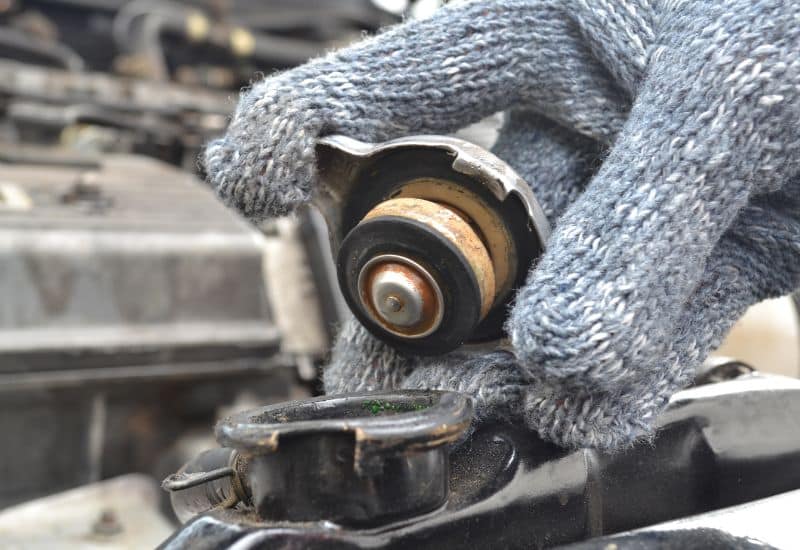
Radiator caps have an average lifespan of 5 to 7 years. At that point, the rubber gasket inside the cap can crack and start to wear out. This alters the seal, which allows air to wheeze in and fluid to seep out without the regulating oversight of the valve.
How to Prevent A Bad Radiator Cap
Preventing bad radiator cap problems all comes down to common sense maintenance. You need to routinely check the cap and the seals when the car is cool. This is the sort of thing you should consider doing every oil change or two. Especially if your engine has been running hot or you recently had a mysterious case of overheating.
Anytime you need to go into the engine bay for something, take a couple of seconds to look at the radiator cap for signs of white residue, which is likely a sign that the seal has failed and the regulating valve isn’t fully doing its job.
Also, an on-schedule radiator flush and fill will help extend the overall life of the radiator cap and other cooling system components.
It removes scale deposits and other contaminants, which can prematurely clog the radiator cap’s relief valve. Not to mention optimizing cooling system performance.
Frequently Asked Questions
Can a bad radiator cap cause the engine to overheat?
A bad radiator can lead to the gradual or even rapid loss of engine coolant, which can cause an engine to overheat. Usually, this is a gradual process, and you might just notice the engine is running a little hot. Sometimes, a compressed radiator hose or ruptured hose can expel a massive amount of coolant in seconds, causing a lot of steam under the hood and rapid overheating.
Is it normal for the radiator cap to fail?
A radiator cap has an average lifespan of 5 to 7 years. Replacing it every five years reduces the risk of causing other faults in your cooling system, which is the real worry when driving with a bad radiator cap.
What happens when you drive a car with a bad radiator cap?
When you drive a car with a bad radiator cap for too long, you risk the eventual loss of cooling fluid. Given enough time, the unregulated changes in pressure can and likely will cause a failure in one or more hoses as well as the hose clamps that hold them in place. As coolant is lost, the risk of catastrophic overheating in the engine goes up.
How often should I change my radiator cap?
You should change a radiator cap every five to seven years. If you are putting a lot of miles on your car, it’s wise to change it every five years, regardless of whether or not it’s failing, just to be safe.
Conclusion
A bad radiator cap is one of those avoidable problems that go along with properly maintaining your car. When the pressure valve fails, or the seal on the radiator cap degrades, the pressure and temperature swings in the engine cooling system can cause hoses and hose clamps to fail.
The gradual or rapid loss of coolant then puts your engine at high risk for overheating and all the problems that it brings!
By simply keeping an eye on your engine coolant, inspecting the radiator cap every oil change or two, and making a point to replace the cap every five years, regardless of how it looks, you can prevent a lot of cooling system problems.

Written By
Jason Farrell
Jason Farrell is a certified master technician, the editor of Mechanic’s Diary in Pittsburgh, Pennsylvania. He is ASE (Automotive Service Excellence) certified and earned a Bachelor’s Degree in Automotive Technology from Pittsburg State University. With nearly 18 prior years of experience in the automotive field, he has extensive knowledge about Domestic, European, and other foreign makes and models of cars and light trucks. Jason’s experience working as a technician and service manager at dealerships, gave him the experience and know-how of most aspects of inspection, diagnosis, and repair from engine and drivability to electrical, HVAC, brakes, steering and suspension and everything in between.

